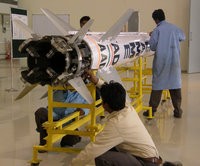Since 2006, India has embarked on a robust ballistic missile defense (BMD) program aimed at a two-tier defense. In that time, the Defense Research and Development Organization (DRDO) has conducted a number of successful missile-interception tests, with the latest coming in February. India’s plan for missile defense, however, dates back to the early 1980s, when it started its Integrated Missile Development Program (IGDMP).
IGDMP envisaged an array of offensive missile platforms, such as the Prithvi and Agni ballistic missiles, as well as the development of defensive missile platforms, such as the Akash surface-to-air missile system. As currently conceived, the Indian missile shield revolves around the Prithvi and Akash missiles, with the Prithvi designed to intercept incoming missiles at 30-50 miles (exo-atmospheric interception) and the Akash designed to operate at a range of 10-20 miles (endo-atmospheric interception).
Though much of India’s missile defense program has been an indigenous effort, foreign partners have also played a significant role, with Israel in particular a major collaborator. Israel has been especially helpful in providing state-of-the-art radar technologies for early detection of hostile projectiles. To bolster its missile-tracking capabilities, India has imported two Green Pine radars, which Israel uses in its Arrow missile defense system. Moreover, India has also developed the Swordfish tracking and fire control radar in collaboration with Israel and France. India had previously acquired Phalcon AWACS from Israel at a cost of $2 billion, providing it with a low-level detection capability for hostile missile platforms and considerably enhancing the response time for missile interception.

